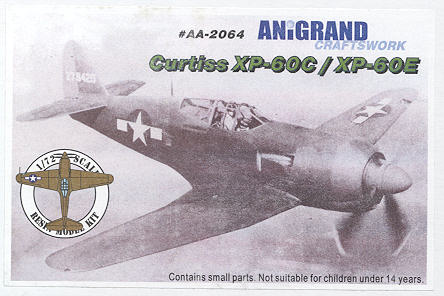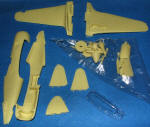
| KIT: | Anigrand 1/72 Curtiss XP-60C/E |
| KIT #: | AA-2064? |
| PRICE: | $49.00 from www.NostalgicPlastic.com . Free shipping in US |
| DECALS: | Two options |
| REVIEWER: | Scott Van Aken |
| NOTES: | Short run resin with vacuformed canopy |

| HISTORY |
The P-60 series of aircraft were the last attempts by Curtiss to build a replacement for the P-40. Previous attempts included the XP-46 and XP-53. The Army Air Corps wanted a "Merlin" powered aircraft so the second XP-53 was modified for the new engine and re-designated XP-60. Because the V-1650 engine was in demand for production aircraft (e.g. P-51), the P-60 underwent many modifications.
The P-60B was to be powered by a Wright engine and the P-60C was supposed to be powered by a new Chrysler engine, but development problems delayed the engine. The P-60C airframe was modified for the proven P&W R-2800, this time driving a contra-rotating propeller. While the first flight of the P-60C in mid 1943 was satisfactory, the USAAF already had a similar or better performing aircraft in the P-47 that was already being sent to units.
The P-60B was modified for the R-2800 as well, but this time fitted with a four bladed prop and designated the P-60E. This was a more promising design than the P-60C due to the less complex prop, but it still was not better than current P-47/P-51 aircraft. Even a redesign to provide a 'bubble canopy' and to remove excess weight was unable to provide an aircraft with any promise so the program was cancelled in mid 1944. The sad truth was that the Army was never really able to make up its mind on this aircraft and what could have been developed into a successful aircraft was actually killed by indecision as much as anything else.
| THE KIT |
 The sturdy box opens to find the usual
compartmentalized bag full of tan resin parts. As I usually do, I opened the
sections with the large parts and left all the little ones in their
compartments. Inspecting the big bits, I found the usual air holes in some of
the thinner parts and on the tips of the wings. I also found a couple of
instances where the thin resin pour stubs had broken off a part, leaving a chunk
to be repaired. Nothing really unusual about this as Anigrand kits can run the
gamut from well done to having more than their share of molding faults.
Generally the kits are closer to well done. As much as you may think "how can
you put up with those things?", the truth is that most of what is out there is
much, much worse in terms of mold flaws. Anigrand's are minor by comparison and
the truth is that fixing them rarely adds more than an hour's work to the kit.
The sturdy box opens to find the usual
compartmentalized bag full of tan resin parts. As I usually do, I opened the
sections with the large parts and left all the little ones in their
compartments. Inspecting the big bits, I found the usual air holes in some of
the thinner parts and on the tips of the wings. I also found a couple of
instances where the thin resin pour stubs had broken off a part, leaving a chunk
to be repaired. Nothing really unusual about this as Anigrand kits can run the
gamut from well done to having more than their share of molding faults.
Generally the kits are closer to well done. As much as you may think "how can
you put up with those things?", the truth is that most of what is out there is
much, much worse in terms of mold flaws. Anigrand's are minor by comparison and
the truth is that fixing them rarely adds more than an hour's work to the kit.
The kit provides the two different props as used on the P-60C and P-60E. In fact, that is the ONLY difference between the two as Anigrand decided not to do the later P-60E with the revised cockpit and bubble canopy as that would have needed new fuselage halves. A nice clear canopy comes with the kit and while the frame lines are still a bit too indistinct for my tastes, it is well molded. This time, the kit comes with a cut out for the landing light and a cover for it attached to the back of the canopy section, so be sure not to destroy that when removing the canopy from the sheet. I should mention that I verified that both spinners were properly drilled. One can never be too careful! Another neat thing is that the wings lock together, thanks to a rather ingenious design. This also gives proper dihedral to the wings. You will have to sand down the edges to remove some excess resin but the engineering is good and most welcome.
I would be remiss if I didn't mention a bit of a short-cut in regards to props. The ones in the kit are rather generic and not exactly what was used on either aircraft. The XP-60E blades are more of what you'd find on a P-47 and the XP-60C ones are actually a bit more pointed on the tips, at least to judge from the photos in several magazines. Anigrand is known for generalizing some aspects of their kits (like prop blades, wheel well detail and wheels), and so it is with this one as well.
Instructions are the norm wit basically an exploded view for construction and a nice markings guide on the back of the sheet. A set of generic mid war insignia are supplied along with two serial numbers. To do an XP-60C during it first flight, you'll need to use the older non-barred insignia from your spares bin. Anigrand decals work well and while a bit resistant to setting solutions, will stick to relatively flat surfaces no sweat. Both of these aircraft are in OD over Neutral Grey, so no worries about unpainted metal finishes!
| CONCLUSIONS |
This one may be a bit more work than the usual jets (thanks to the engine and prop and blades), but still is a kit that someone new to resin kits should be able to successfully complete if they take their time and test fit EVERYTHING twice! I'm thrilled that Anigrand is doing some of these WWII prototypes and am looking forward to seeing more of the same.
September 2006
My thanks to Anigrand USA for the preview kit. Get yours at the link with free US shipping.
If you would like your product reviewed fairly and quickly by a site that has nearly 325,000 visitors a month, please contact me or see other details in the Note to Contributors.